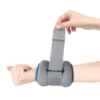-
Weight Cuff ₹979.00 QTY: 1
Beauty & Health, Health and Wellness, Innovative Wellness Technologies, Pain Relief Solutions, Self-Care & Relaxation
Innovative Features in Modern Massage Devices
Welcome! Massage devices have come a long way from simple handheld gadgets to advanced machines with smart technology. These devices are designed to relieve stress,…


